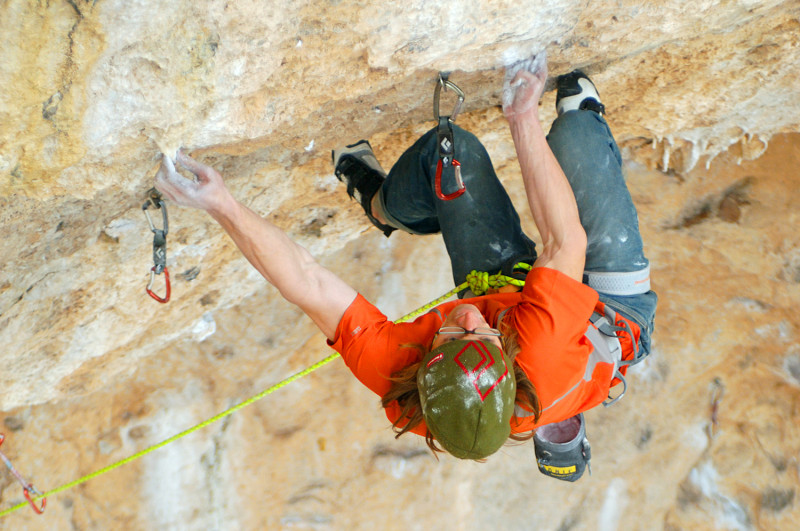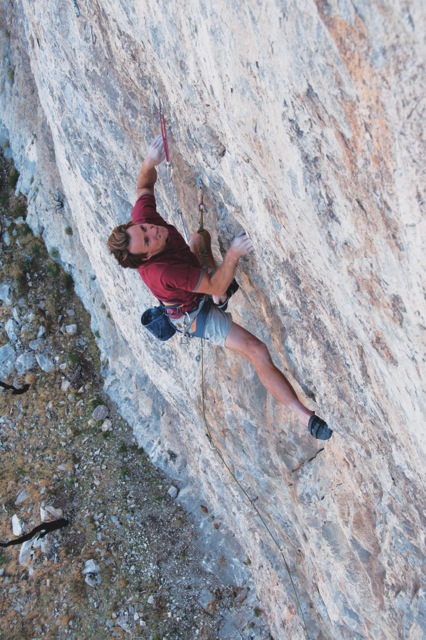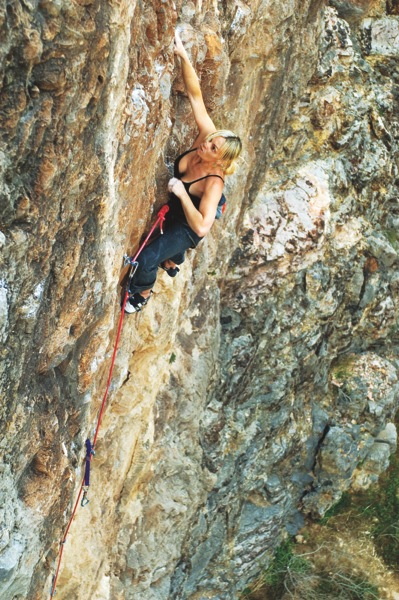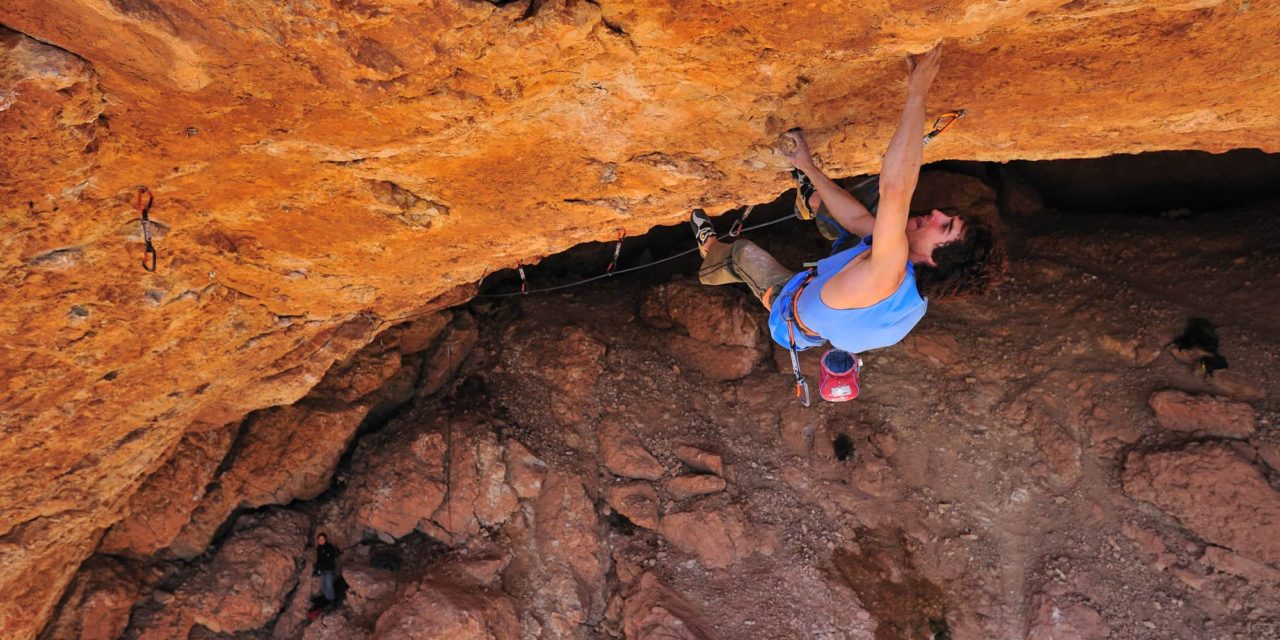Running through the Utah Hills, old Highway 91 winds from St. George, Utah, to Littlefield, Arizona. The old two-lane road, mostly abandoned in favor of I-15, is of central importance to climbers. The Utah Hills hold some of the best sport climbing in the U.S., with outcroppings of steep, bullet limestone dotting the desert landscape. Famous crags such as Black and Tan Wall, Sunset Alley, Welcome Springs, and the Virgin River Gorge are all located within a 15-mile radius.

Andy Raether. Photo: Keith Ladzinski

Misty and Bill
Spend time climbing around St. George, and you’ll likely hear the names of locals such as the husband and wife team of Bill Orhan and Misty Murphy, as well as Todd Perkins and Todd Goss, who, along with the help of many others, have made the Utah Hills a mega destination for limestone sport climbing.
As the popularity of the area has increased over the last 15 years, so has the demand for a comprehensive guidebook to the region. Enter Misty and Bill, who have recently put together The Limestone Bible, a a new sport climbing guidebook to over 740 routes and 21 different areas located in Southwestern Utah, the Arizona Strip, the Virgin Mountains and Arrow Canyon. Detailed topos and beautiful photos round out the book, which has clearly been a labor of love of two of the most dedicated and passionate locals, route-developers and now, guidebook authors, from this region.
“Yea, of course, we wanted to have these crags to ourselves,” says Bill, who has established hundreds of routes in this region. “But St. George has gotten to the point where we need to direct people to the right trails and the right camping. Word is out, people are coming, we knew it was time.”
I sat down with Bill at the Outdoor Retailer trade show, to find out more about this prolific, if reticent, route developer.

Joe Kinder, Hurricave. Photo: Keith Ladzinski
Where is the first route you ever bolted?

Bill Ohran on his 24-bolt route The Family Jewels (5.13a), at the Diamond. Photo: Jorge Visser
Rock Canyon in Provo Utah. I grew up there, where as Misty grew up in Salt Lake. Then Maple Canon, I also did some bolting in the VRG and Utah Hills in the early 90’s before I moved down there as well.
Do you have a favorite first ascent?
Everyone always asks me that but I like so many of them, I can’t narrow it down to one or two. At the Cathedral I really like Indulgence (5.13b).
Who got you into bolting?
Shortly after getting into climbing I had heard about new routes going up in American Fork in the late ‘80s. It just interested me, you read a guidebook and it says who did it first. That just made me think why and how did they do it, what do I need to do it?
So it just intrigued me. as a skateboarder, we built half pipes and built what we need to play on, so that mentality just seemed to work. By the time I started hanging out with Jeff Pederson, and watched how he did it, I changed my approach. Tools have gotten better and better, too. My first drill was a gas powered Ryobi drill. A huge pain in the ass. Pretty glad I don’t have that anymore.
How has the BLM reacted to fixed draws and other permanent markings left by climbers?

Misty Murphy on ‘Heart of Glass’ (5.12c/d) Arrow Canyon, Nevada. Photo: Keith Ladzinski
So far they don’t like it. They’d like to see things like fixed draws get taken down. I don’t think they have been to the Cathedral in the last couple years. We have had other areas where they complained about the draws, and also things like ropes left for hand over handing on slabs or steep gullies. I hope they don’t have a problem with leaving that kind of stuff around because it’s used all the time and it’s strictly for safety. Thats why it’s imperative climbers always tread lightly in the Utah Hills.
There are also cliffs in proximity to Indian Reservations, so climbers just always need to be aware and respectful.
You have spent a lot of time recently developing the Diamond—a multi-pitch wall. How is that going?
Well compared to what the Diamond was 20 years ago it’s impressive, we have been up developing for four or five years now. Some of my favorite routes were bolted last year and even this year some of the new shit is going to be just as good. We’re psyched to get people up there to check it out.
Would you say there’s still a good amount of potential left for new routes?

Local developer Todd Perkins on his route Sunset Lanes (5.11d), Sunset Alley.
Some might say theres a lot, but they might be basing that on lowering the standards. Take American Fork, for example. A whole bunch of new 5.10s have been established recently, but they are not really that great in my opinion. If you’re looking for amazing caves, they are a little more rare. There’s a few tufa caves out there, though, but it’s mostly hard stuff. Like, really hard.
Most of the potential lies in the Mormon Mountains. You can see it from the freeway, or from the Utah Hills. We think the Mormon Mountains will be in our second edition.
There’s still a lot of development that is happening and it’s hard to pin it down and put it in a book. It’s not just like Welcome Springs, where it’s like, here’s a crag to walk up and do all these routes. It’s very spread out and hard to find.
The Limestone Bible is now available with free shipping (for a limited time).




Thanks Misty and Bill for an excellent guide. Can’t wait for some crisp fall weather!